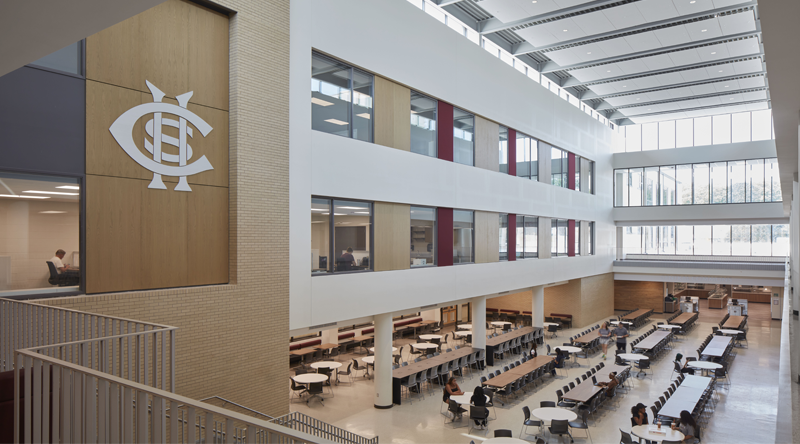By Mark Jolicoeur
Beginning with master planning in 2016 and continuing through intensive community and school district engagement – with thousands of contacts including meetings, surveys, and focus groups – global architecture and design firm Perkins&Will and associate architect IGW Architecture transformed two public high schools in Champaign, Ill., to support future-ready education. The designs for the schools, located four miles apart, combined renovation, additions, and reorganization. Flexible libraries/media centers, STEM/STEAM/Engineering Science facilities, project-based learning spaces, and versatile performance areas combine to meet ever-evolving educational needs.
The most extensive work was undertaken at Champaign Central High School, built in 1934 and located in an historic residential neighborhood. The renovation included a remodel of the existing structure, along with three separate additions totaling more than 317,000 square feet – and, responded to community interests in “Keeping Central Central” in the same location. The district purchased several contiguous properties across the street from the main campus, vacating two streets to achieve a consolidated cohesive campus. To unify the campus, a landscaped visitor parking lot with passive stormwater management and spacious athletic facilities were infilled adjacent to the original building, preserving the facade of the historic fieldhouse as an athletic entrance.
Renovations balanced the school’s imposing exterior with the addition of three contemporary additions and a new main entrance, doubling the size of the original building. Students now enter Champaign Central through the north entrance, distinct from staff and student parking, easing congestion and passing through a contemporary security sequence with a welcoming school identity. A 750-seat auditorium was added, classrooms modernized, energy-efficient windows installed throughout the school, and audio-visual and mechanical systems upgraded. The design provides enhanced opportunities to explore career paths such as welding, automotive technology and carpentry in new career and technical education spaces.
By taking advantage of outdoor spaces, the cafeteria and kitchen were relocated from the basement to the ground floor, opening into a light-filled commons and dining area closely connected to the rest of the school and with space for larger events. The new configuration provides room for a state-of-the-art Culinary Arts program linked to the dining area.
Athletic facilities were upgraded and, in some cases, reorganized. The basketball court’s wood floor was replaced, while recreating archival art deco graphics and paying homage to a long-time and beloved coach. The gym’s historic character with its blonde brick walls was maintained. The new north addition to the athletic facilities serves as an ICC-500 rated storm shelter, and includes a sunlight-drenched dance studio equipped with tornado-resistant windows. The new planning made room for a softball diamond, a soccer field, and a practice competitive marching band field.
At Centennial High School, built in 1967, the original façade presented a key challenge – large expanses of beige brick, with little natural light and a hard-to-locate front door. A new entrance with vertical, two-story glass windows matches the height of the building and floods the interior with natural light – enlivens the experience for both students and visitors.
Inside, new administrative offices, industrial arts facilities, and classrooms were added, maintaining the original brick styling. Students can now meet informally in two internal courtyards with sightlines from large windows into the labs, cafe, library, and interior collaboration spaces. Exterior bas relief panels from the 1960s were stabilized and provide colorful backdrop in the landscaped courtyards.
The design for both schools emphasizes sustainability, safety, and flexibility. Energy-efficient HVAC and lighting systems and integrated natural light reflect the importance of adaptability. Resilient storm shelters with high-impact resistant glass meet ICC 500 requirements –tested to an impact rating ten times greater than Miami hurricane standards – ensuring student safety during severe weather events.
Mark Jolicoeur is a principal with Perkins&Will and has collaborated with both public and private educational institutions regionally, nationally, and internationally on various project types, including renovation, adaptive re-use and new construction.


